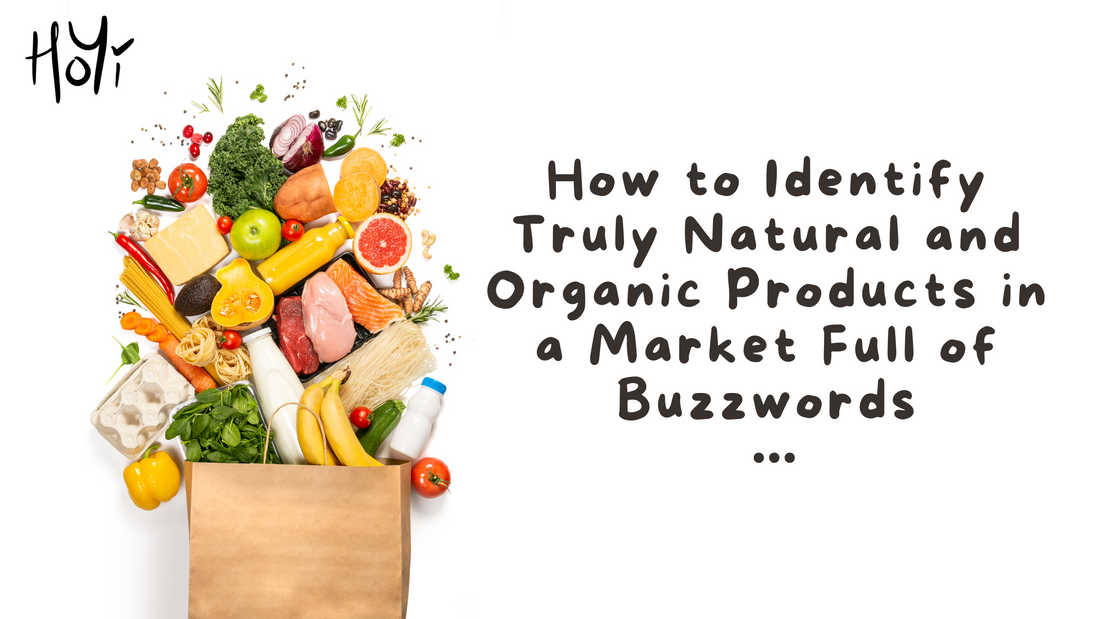
How to Identify Truly Natural and Organic Products in a Market Full of Buzzwords
Share
In today’s world, where almost every product is labelled with terms like “Natural”, “organic”, “eco-friendly” and “pure”, it is easy to feel overwhelmed. These buzzwords promise a healthy and sustainable lifestyle but every time we get that question how much of it is actually true?
Post Covid and the Jio era has made consumers more curious and conscious of their choices. But we have always seen that the companies observe the trends and market their products accordingly and some of them try to exploit it using clever marketing tactics. The result is that the consumer gets lost in the noise and is not able to identify the right products and eventually loses faith in all such brands.
This blog is going to help such consumers on how to identify the right products.
What do “Natural” and “Organic” really mean?
First of all Natural and organic are two different terms and are often misused.
Natural Products
The term “natural” is one of the most abused buzzwords in marketing. Legally speaking, there is often no strict regulation for labelling a product as natural. It is supposed to mean that the product’s ingredients come from natural sources—like plants, minerals, or animals—and haven’t been heavily altered. However, many so-called natural products still contain synthetic additives, preservatives, or harsh chemicals.
For instance, a “natural” face cream might contain aloe vera extract but could also be loaded with parabens or synthetic fragrances. The key takeaway? “Natural” doesn’t necessarily mean safe or chemical-free.
Organic Products
Organic, on the other hand, has a clearer definition. Organic products are made from ingredients grown without the use of synthetic pesticides, fertilizers, or genetically modified organisms (GMOs). These products often have certifications from regulatory bodies like USDA Organic, India Organic, or ECOCERT.
However, even here, the waters can get muddy. Terms like “made with organic ingredients” can be deceptive. A product might contain just 70% organic ingredients and still make the claim. This is why certifications matter which gives the brand the claim that their products are organic.
Like we said at the start there are clever marketing tactics to beat the system.
1. Lack of Certifications
A genuinely organic product will almost always have a certification logo from a recognized body. If you don’t see certifications like USDA Organic, India Organic, or Soil Association, it’s worth questioning the authenticity of the product’s claims.
2. Buzzwords Without Proof
Phrases like “100% natural,” “non-toxic,” and “pure” are often thrown around without any regulatory oversight. Always check the ingredient list to see if these claims hold up.
3. Greenwashing Practices
Greenwashing is when companies use deceptive tactics to appear environmentally friendly or sustainable. For example, a shampoo bottle might say “biodegradable” on the front but contain sulphates and silicones in the ingredients list.
4. Overly Vague or Misleading Labels
Labels that list generic terms like “fragrance” or “natural flavour” can hide a cocktail of synthetic chemicals. If a company isn’t transparent about its ingredients, it’s a major red flag.
How to Read Labels Like a Pro
Knowing how to decipher labels is your best weapon against misleading claims. Here’s how to do it:
1. Look at the Ingredients List
Ingredients are listed in descending order of quantity. If the first few items include water or synthetic chemicals, the product isn’t as “natural” as it claims to be. Look for clear, recognizable names like coconut oil, shea butter, or essential oils.
- Avoid products containing:
- Parabens (methylparaben, propylparaben, etc.)
- Synthetic fragrances or “parfum”
- Sulphates (SLS, SLES)
Artificial dyes and preservatives
2. Check for Certifications
Certifications act as a stamp of credibility. Some common ones include:
- USDA Organic: Ensures the product is made of at least 95% organic ingredients.
- India Organic: Certifies organic farming practices in India.
- ECOCERT: A European certification for organic and sustainable products.
3. Research the Brand’s Transparency
Does the brand disclose where its ingredients come from or how its products are made? Ethical, transparent brands are usually open about their sourcing and manufacturing processes.
Supporting Ethical and Transparent Brands
As consumers, we have the power to influence the market by choosing brands that align with our values. Ethical brands go beyond buzzwords; they prioritize transparency, sustainability, and quality.
1. Look for Sourcing Information
Does the company source its ingredients sustainably or work with small farmers? For example, HoYi—a brand committed to using fresh, natural ingredients from local farmers—is an excellent example of transparency and sustainability in action.
2. Trust Customer Reviews
Real reviews can be incredibly telling. Look for detailed feedback on the product’s quality, effectiveness, and whether it matches the brand’s claims.
3. Use Technology to Verify Claims
There are apps and websites that help verify the authenticity of products. Tools like EWG’s Skin Deep database or the Think Dirty app can be invaluable for checking ingredients and certifications.
Sustainable Shopping Practices
Being an informed consumer isn’t just about choosing the right products—it’s about adopting sustainable shopping habits that align with your values.
- Shop Local and Small-Scale
- Research Before You Buy
- Embrace Minimalism
Navigating the maze of buzzwords in today’s market can be daunting, but it is far from impossible. By understanding the true meaning of terms like “natural” and “organic,” learning to read labels critically, and supporting ethical brands, you can make choices that are healthier for you and the planet.
Remember, every purchase you make is a vote for the kind of world you want to live in. By being an informed and conscious consumer, you’re not just buying products—you’re supporting a movement towards authenticity, sustainability, and integrity in the marketplace. So the next time you’re shopping, take a moment to look beyond the buzzwords and make a choice you can truly feel good about.

